gaming
Miladycraft: The Grand Remilia Ball and ‘Network Spirituality’ in Minecraft
Published
4 months agoon
By
admin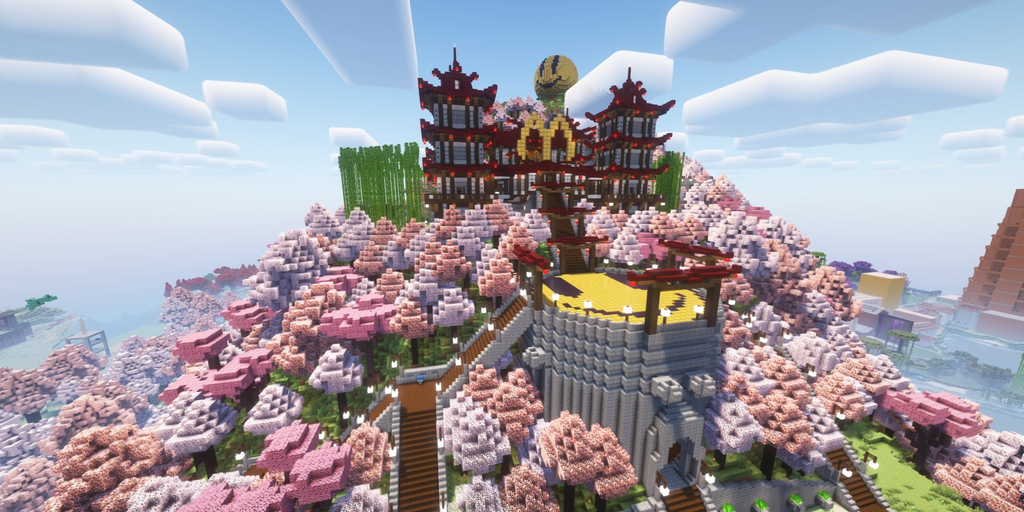
A custom Minecraft game server acts as both a key meeting place and an immersive, philosophical art piece at the center of Milady Maker—one of Ethereum’s most popular and subversive NFT projects.
Built around rich theories on the modern world and micro-communities full of lore, the Milady Minecraft server or “Miladycraft” was created by holders of the Remilia Corporation NFT projects (like Milady Maker and Redacted Remilio Babies) for members to enjoy.
But it’s more than just a place to hunt for diamonds and build dirt huts in a blocky voxel environment. According to the server founders, Miladycraft is an art piece in and of itself.
In 2021, two community members wrote the “Milady World Minecraft Server White Paper” with the guidance of the collection founder, Charlotte Fang.
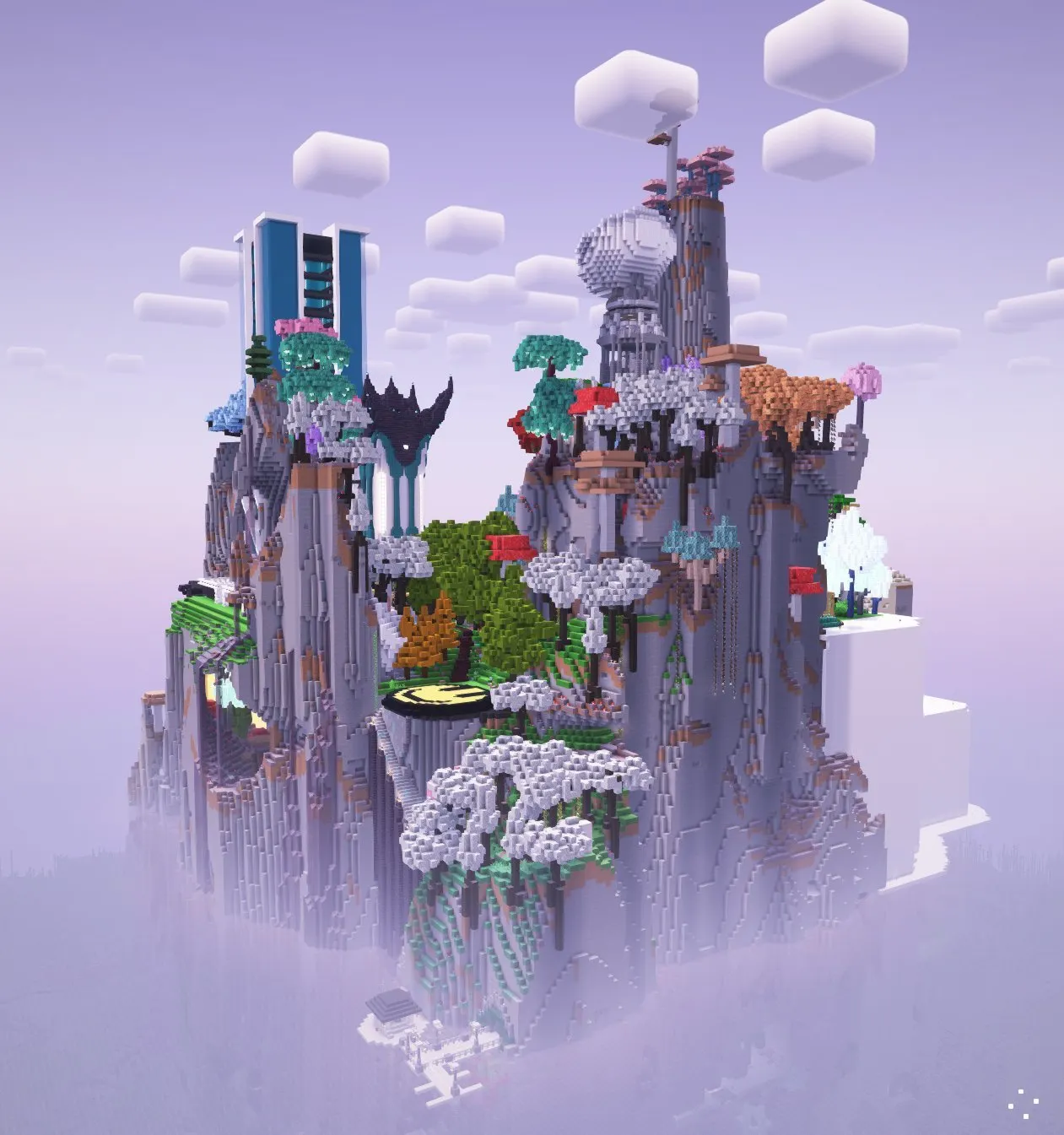
“Milady World might seem simple, as it is solely a Minecraft server—factually that is correct—but with it we wish to explore modes of sociality,” the white paper concludes. “With Milady World, we intend to harness human impulse unto inner fulfillment.”
It’s a rich document teeming with explanations of video game history, personal asides, and apparently sincere statements that might make readers crack a smile. For example, it asserts that Minecraft has “stimulated some of the greatest conversations in recent times known to man,” and that it “acts as the modern digital businessman’s golf.”
(It also imagines wild competitive success: “In another world, Milady could have been redefining esports, players whose caliber would be unmatched in the gaming world, forever; a golden age ushered in not by the mechanical greatness and artistic splendor of the games, but by the raw, unrelenting rockstars of gamers that could not seem to fail at succeeding, no matter what.)
In practice, the Miladycraft modpack and server have been used for social experiments, such as last month’s Second Annual Grand Remilia Ball. Intended to emulate the atmosphere of a real-world ball, the event was hosted in a lavish custom-built hall with attendees’ avatars dressed to the nines in virtual formalwear—and accompanied by a date.
“The purpose is, ultimately, because it’s fun and funny,” pseudonymous server co-founder and event organizer Scorched Earth Policy told Decrypt. “But deconstructed, a necessity for the structure is due to online events having a natural entropy towards chaos.”
As a result, the event organizers believe it’s important to enforce that every attendee must bring a date, and highly recommend that they be female—Milady NFT not required. In part, this is to reduce the risk of the event having no hint of a Y chromosome. But it’s also because they believe it reduces the risk of trolls and annoying jokesters.
“Said jokers would either be unable to find a date, or wouldn’t dare to incite such embarrassment upon their date either way,” Onno Morrison (who goes simply by Onno online), the server’s co-founder, told Decrypt.
“It’s just a fundamentally true principle that gender ratio will mathematically proportionately decide how fun your party will be,” Scorched Earth Policy claimed. However, the desired gender ratio was ultimately not rigidly enforced.
Some Milady community members scrambled for dates to enter the ball. However, the process of dating someone purely through the internet (called edating) is strictly prohibited by Milady creator Fang. As such, community members are encouraged to go out and speak to people in the real world to find a companion for the virtual ball.
Some attendees took long-standing partners, while others asked friends to join them—and a few indeed resorted to the internet to find a date, including DeGods and y00ts NFT project founder Frank DeGods, who tweeted out a request. One community member even set up a matchmaking Twitter account, although not a single match was made.
One attendee, who goes by the name Jeffortless, asked their date out by sending them a bouquet of flowers and a Hello Kitty Kuromi plushie. The pair have never met in real life, but Jeffortless insists that they aren’t an edater.
“It wasn’t romantic intent,” Jeffortless told Decrypt. “Sure, people can look at it that way or even practice courtship, so it sort of seems like dating. But I don’t, nor did I treat it like dating.”
Minecraft as art
To the creators, Miladycraft is more than a simple Minecraft server. It’s a work of art.
Scorched Earth Policy and Onno were having lengthy discussions about Minecraft back in 2021, itching to play the game again. But those conversations were effectively going nowhere until Fang prompted them to start documenting their discussions—like a modern day Socrates and Plato.
“Such a distraction could not be justified unless it was made applicable towards propelling Remilia’s financial or artistic merit,” Scorched Earth Policy explained. So the pair embarked on critiquing the state of Minecraft, modern gaming, and broader society in their elaborate white paper.
“Long after Miladycraft becomes defunct or forgotten, the white paper will go on to demonstrate the cultural significance of what we’ve assembled,” Scorched Earth Policy said. “The white paper is the art; the server is the work that makes it art and gives it reality.”
One of the white paper’s core arguments is that Minecraft is ultimately flawed due to Mojang’s mismanagement, steering the game towards children. It stresses that socialization in the virtual world is real and that the human experience is mirrored in the world of gaming.
Minecraft can serve as a sufficient metaverse, the white paper contends, and already has in many ways—but in their view, years of mismanagement prevented this vision from ever being fully realized. The team set out what it would take for Minecraft to match their own vision, and originally planned for the server to be free of moderators, but ultimately changed course there.
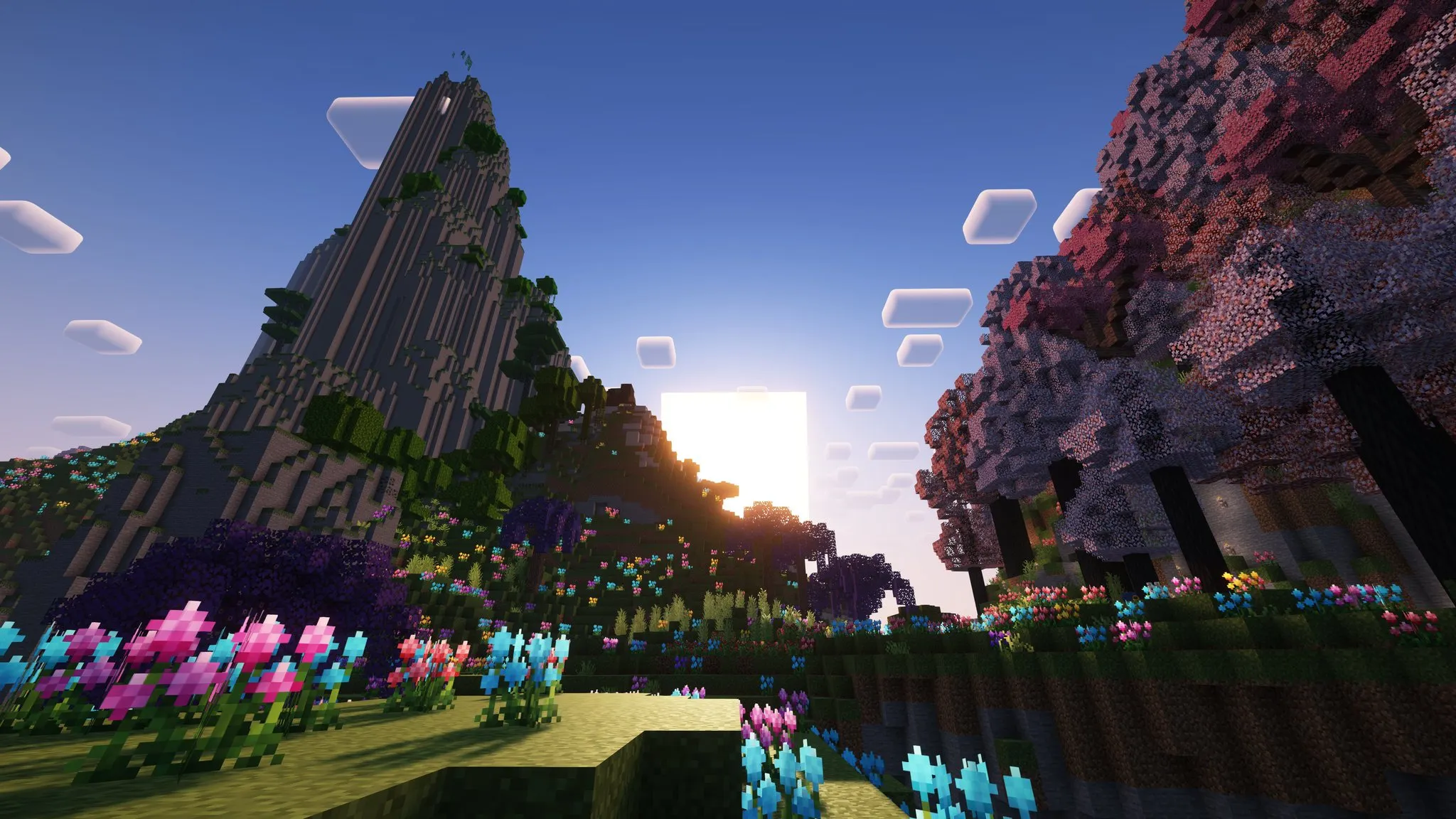
The white paper also goes into depth on how reality and the virtual gaming world connect. It stresses that socialization in the virtual world can feel just as vivid as real life, and that gaming is a precursor to an inevitable era of digitally simulated reality.
“[Minecraft] was the first truly open-world, open-possibility game ever created, and its existence marks an extremely important moment in history,” Scorched Earth Policy said. “Not just for video games, but for metaverses and the internet itself.”
With its creation, the server has played host to countless golden nuggets of lore and has been compared by players to the legendary 2b2t Minecraft anarchy server. For example, in Miladycraft, a seed phrase to a wallet containing 10 ETH (about $27,500 worth) has been hidden near the spawn point and has still to be found in a forever ongoing hunt.
Minecraft as philosophy
For many Remilia Corp. aficionados, Miladycraft links back to one of the core philosophical theories of the community: “network spirituality.”
This concept has been unpacked, evolved, and challenged by many, with a concrete definition still hard to come by. But at its most basic, it’s a spiritual network embedded in internet culture and memes; a rejection of the individual’s “meat-space ego” and the embrace of a connected digital being, with each person comprising a single node.
“Network spirituality is the collective prana of thousands of young artists channeling their artistic vision and manifesting it online,” one definition outlines, with prana meaning “breath” or “life force” in Sanskrit. “Network spirituality is the layer upon layers of user-generated sites,” another explains.
To many Miladycraft players, the server is an example of this in action. As the server lives, lore is created and memes evolve—contributing to the collective brain. One player, who goes by the name TylerIRL, told Decrypt that the evolution of network spirituality is the real art piece when looking at the Milady NFT collection.
“Miladycraft is network spirituality in practice,” Kabuki, a pseudonymous gamer who has played on the server for two years, told Decrypt.
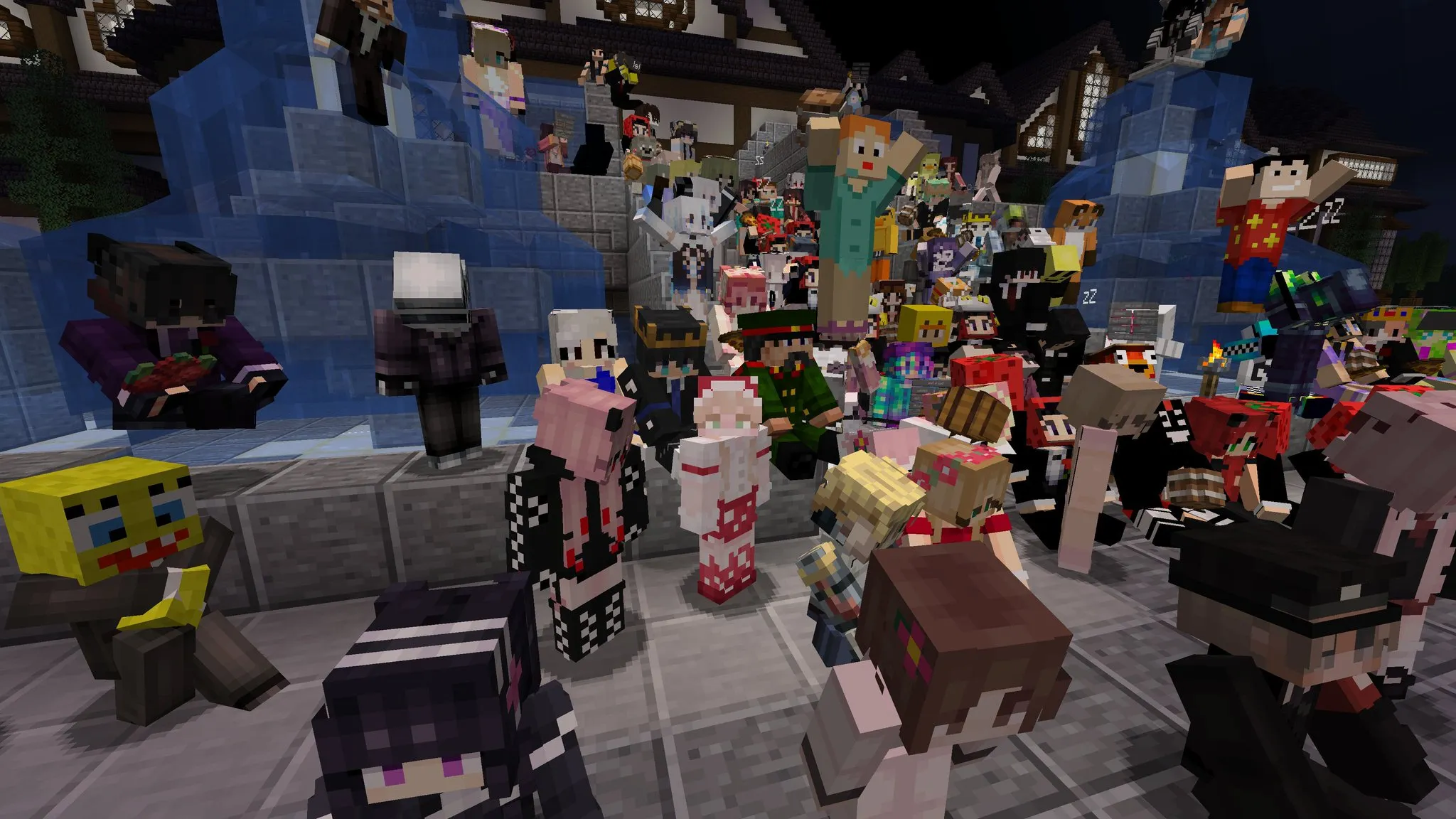
“Nowhere else have I played with so many talented, bright, interesting, psychologically enigmatic, and spiritual individuals,” he said. “Truly, the Milady community must be one of the hotspots, in not only crypto but in the broader global culture.”
“Engaging with Milady is engaging with your innermost modes of being,” Kabuki added.
As the dust settles on the second annual ball, the network’s hive mind has only grown stronger. Lore will be passed down by collectors, tales will be told by gamers, and the Miladycraft metaverse art piece will continue to transform.
Edited by Andrew Hayward
GG Newsletter
Get the latest web3 gaming news, hear directly from gaming studios and influencers covering the space, and receive power-ups from our partners.
Source link
You may like


Trader Says Top-10 Altcoin To Vastly Outperform Bitcoin and Ethereum, Hit New Record High Quicker Than Expected
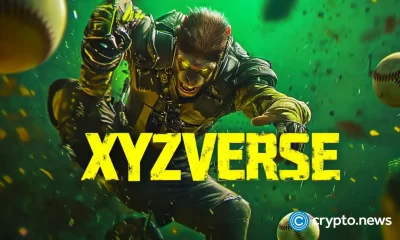

5 tokens to consider buying today
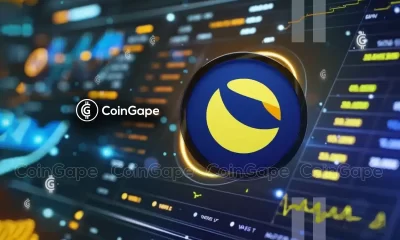

Terra Luna Classic Community Discord On Proposal Amid LUNC Price Rally


Trump Nominates Pro-Crypto Hedge Fund Manager Scott Bessent as Treasury Secretary


Dogecoin surges 10% as this new altcoin shakes the market, and preps for stage 2 presale


Ripple CEO Shares Bullish News With XRP Army As Trump Names Treasury Secretary
blockchain games
HashCats prepares for Token Generation Event after completing mining season
Published
2 days agoon
November 21, 2024By
admin

HashCats, a tap-to-earn miner game, is concluding its first season and shifting focus to its upcoming Token Generation Event.
With nearly five million players engaged in the game’s first six months, HashCats has announced a $500,000 giveaway in collaboration with its partner Choise.ai to reward players ahead of this next phase, according to a release shared with crypto.news.
T2E games, which allow users to earn cryptocurrency by playing, have gained attention but faced challenges in maintaining long-term engagement. Games like Hamster Kombat and Catizen (CATI) initially sparked hype but have struggled to sustain user interest.
HashCats is trying to buck this trend by expanding its ecosystem and enhancing player incentives.
HashCats background
Tap-to-earn games let users generate cryptocurrency by playing simple games. In HashCats, players mine $HASH tokens by tapping their screens and upgrading virtual mining equipment. These tokens can then be converted into cryptocurrency or used within the game’s ecosystem.
Unlike traditional games that charge for upgrades, T2E games aim to provide a potential income stream for players.
Season 1 of HashCats introduced basic mining mechanics, enabling players to use a single virtual ASIC miner designed for mining specific digital currencies based on their hashing algorithms.
According to the release, Season 2 will expand this concept, enabling players to manage a full mining farm and introducing Secret Points, which boost TGE rewards. Players from Season 1 who accumulated SP through contests and giveaways will gain an advantage in the new phase.
HashCats and Choise.ai Collaboration
The partnership with Choise.ai, a platform that merges traditional finance with blockchain, adds an extra layer of incentives.
The ongoing $500,000 giveaway includes events like the “Wheel of Fortune” contest, where players can win CHO tokens. Choise.ai also plans to launch Visa and Mastercard options tailored for HashCats players.
Source link
Dogecoin
How Dogecoin Beat ’Em Up Game ‘Super Doginals’ Came to Life
Published
6 days agoon
November 18, 2024By
admin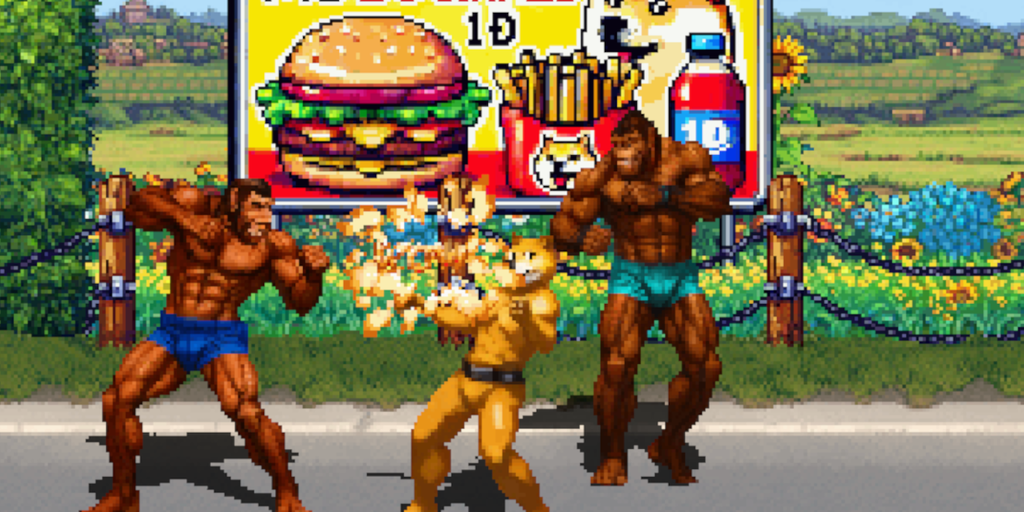
The launch of arcade-style beat-’em-up game Super Doginals came at an opportune time this month, being inscribed on the Dogecoin blockchain right as the original meme coin saw a resurgence in demand and attention, with DOGE hitting a three-year price peak.
But there’s little indication that the rollout was specifically timed like that. As pseudonymous creator Pimax told Decrypt, the game was created in honor of the fun vibes that have defined Dogecoin and its community for over a decade.
“I created Super Doginals as a tribute to the Doge spirit and playful culture,” they said, “adding my own touch to it.”
Super Doginals is particularly polished and robust for a web game, let alone a crypto game inscribed directly onto a blockchain. It’s simple in design, taking its cues from classic button-mashing brawlers like Fatal Fury and Streets of Rage, but has charming artwork and music, and really does capture the spirit of the meme coin’s fandom.
Pimax said that the game was developed using OpenBOR, an open-source game engine, which was ported to the WebAssembly language to run well in web browsers and remain compatible with the Doginals protocol standard.
It’s also a “lightweight” engine, they said, which was key for a game that would be fully inscribed onto a blockchain. Meanwhile, the old-school pixel art vibe both paired well with the retro gameplay and didn’t take up too much space, though the original music posed a bigger challenge.
“Pixel art was an ideal choice because it’s lightweight and scales nicely on higher resolutions without needing extra data,” said Pimax. “The heaviest component was the music—35 minutes in total—so we compressed it into the web-friendly OGG format to keep it Dogecoin-compatible.”
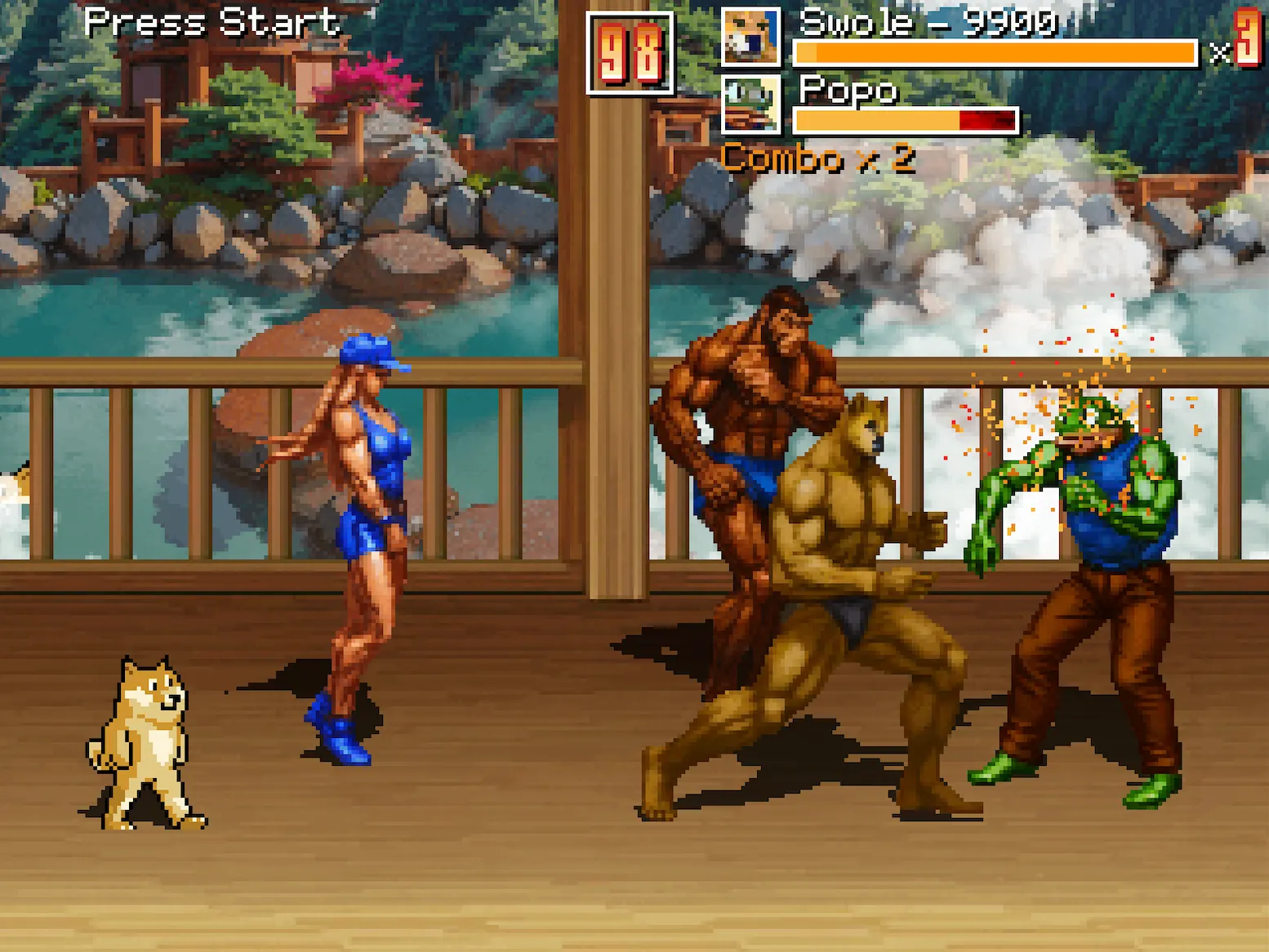
Pimax wanted to put everything on-chain, right on Dogecoin’s blockchain itself via Doginals—a protocol that, like the earlier Ordinals for Bitcoin, lets users inscribe artwork, code, and other data onto the chain. That can yield assets akin to NFT collectibles, but it can also enable interactive games and apps that fully live on-chain.
The builder first experimented with on-chain games on Dogecoin earlier this year, porting over the original shareware version of first-person shooter Doom, as well as launching a Doge-themed riff on Tetris.
But Super Doginals is a much more ambitious project—not just because it’s an original creation, but also because the size of the game requires the use of multiple inscriptions that work together as one in a process called recursion. Doginals then pulls all of the pieces together into a single, playable game, plus that approach unlocks potential add-on features as well.
🌕✨ It’s Super Doginals Time! 🎮✨
The first full-fledged game on Dogecoin is now live!
A retro, action-packed beat ’em up, launched FREE as a Doginal inscribed forever on Dogecoin L1! 🚀
➡️ Play now full screen with just one click:https://t.co/EAhQVNVKq8
➡️ Inscription… pic.twitter.com/11MsWMw6UM
— Mini Doge (@minidogeart) November 9, 2024
“We inscribed the game engine, assets, and utility functions separately, then tied them all together in a final Doginal,” said Pimax. “This approach enables others to build on Super Doginals by adding their own levels, characters, or even creating entire games on top of existing on-chain content.”
Players will also be able to create a “delegate” inscription to have a version of the game in their own Dogecoin wallet, and playable through compatible wallet apps. Pimax said that details on this process will be shared in the near future.
Super Doginals was clearly born from Pimax’s own passion for Dogecoin and the community, but they shared that AI tools were used to make this a manageable solo project. In their view, the AI tools only helped them execute on that vision, rather than strip away their human touch.
“As a solo developer, I used AI tools to accelerate development—whether drafting art, composing music, coding, or gaining insight,” they said. “Today’s AI tools give developers superpowers. While they don’t replace human talent or creativity, they provide a massive productivity boost, making it possible to create a game like this.”
“It still required many months of work with a lot of hands-on effort,” Pimax concluded, “but AI, combined with ingenuity and determination, made it possible to tackle this project on my own.”
GG Newsletter
Get the latest web3 gaming news, hear directly from gaming studios and influencers covering the space, and receive power-ups from our partners.
Source link
gaming
Here Is Today’s ‘Tomarket’ Telegram Game Daily Combo
Published
2 weeks agoon
November 8, 2024By
admin
Telegram crypto game Tomarket is currently conducting its airdrop process via The Open Network, but the game is still letting players rack up tomatoes for potential future rewards.
Tomarket offers various ways to earn tomatoes, including by farming them over a three-hour span, playing a game where you’ll swipe over falling tomatoes, and completing tasks that point you towards YouTube videos and other Telegram games and communities.
But now Tomarket has launched another way to juice your earnings, adding a daily combo feature. Unlike the daily combos seen in games like Hamster Kombat and Captain Tsubasa: Rivals, this one gives you a grid of little pixel characters and tasks you with tapping the three faces in question—and in the right order.
Tomarket offers teases of the solution via YouTube videos, but Decrypt’s GG will make it easy on you: We’ll be updating this guide daily for the foreseeable future with the latest solution, as seen below. Enjoy the free digital tomatoes.
Tomarket daily combo
Tomarket’s daily combo is found by tapping the Tasks button at the bottom of the screen. You’ll need to watch the YouTube video listed under “Time-limited tasks” and successfully claim the reward before entering the combo, so be sure to do that first.
Here is the daily combo solution updated on Friday, November 8:

The daily reward is 15,000 TOMATO, 2 stars, and 3 tickets.
Editor’s note: This story was originally published on October 16, 2024 and will be updated daily with the latest combo.
GG Newsletter
Get the latest web3 gaming news, hear directly from gaming studios and influencers covering the space, and receive power-ups from our partners.
Source link

Trader Says Top-10 Altcoin To Vastly Outperform Bitcoin and Ethereum, Hit New Record High Quicker Than Expected

5 tokens to consider buying today

Terra Luna Classic Community Discord On Proposal Amid LUNC Price Rally

Trump Nominates Pro-Crypto Hedge Fund Manager Scott Bessent as Treasury Secretary

Dogecoin surges 10% as this new altcoin shakes the market, and preps for stage 2 presale

Ripple CEO Shares Bullish News With XRP Army As Trump Names Treasury Secretary

On-Chain Data Shows The Bitcoin Price Bull Run is Far From Over

Trump Picks Pro-Crypto Hedge Fund Manager Scott Bessent for Treasury Secretary

Crypto millionaires will be made by April 2025: 6 coins to hold

Cardano Price Hits $1 But Analyst Says This Is Just The Start

Legacy Media’s Transformation: Why Evolution Beats Extinction

Massive Ethereum Buying Spree – Taker Buy Volume hits $1.683B In One Hour

Ethereum lags behind Bitcoin but is expected to reach $14K, boosting RCOF to new high

Bitcoin Miner MARA Buys Another 5771 BTC As Price Nears $100k

Jason "Spaceboi" Lowery's Bitcoin "Thesis" Is Incoherent Gibberish
182267361726451435

Top Crypto News Headlines of The Week

Why Did Trump Change His Mind on Bitcoin?

New U.S. president must bring clarity to crypto regulation, analyst says

Ethereum, Solana touch key levels as Bitcoin spikes

Will XRP Price Defend $0.5 Support If SEC Decides to Appeal?

Bitcoin Open-Source Development Takes The Stage In Nashville

Bitcoin 20% Surge In 3 Weeks Teases Record-Breaking Potential

Ethereum Crash A Buying Opportunity? This Whale Thinks So

Shiba Inu Price Slips 4% as 3500% Burn Rate Surge Fails to Halt Correction

‘Hamster Kombat’ Airdrop Delayed as Pre-Market Trading for Telegram Game Expands

Washington financial watchdog warns of scam involving fake crypto ‘professors’

Citigroup Executive Steps Down To Explore Crypto
Mostbet Güvenilir Mi – Casino Bonus 2024

Bitcoin flashes indicator that often precedes higher prices: CryptoQuant
Trending

 2 months ago
2 months ago182267361726451435

 24/7 Cryptocurrency News3 months ago
24/7 Cryptocurrency News3 months agoTop Crypto News Headlines of The Week

 Donald Trump4 months ago
Donald Trump4 months agoWhy Did Trump Change His Mind on Bitcoin?

 News3 months ago
News3 months agoNew U.S. president must bring clarity to crypto regulation, analyst says

 Bitcoin4 months ago
Bitcoin4 months agoEthereum, Solana touch key levels as Bitcoin spikes

 Price analysis3 months ago
Price analysis3 months agoWill XRP Price Defend $0.5 Support If SEC Decides to Appeal?

 Opinion4 months ago
Opinion4 months agoBitcoin Open-Source Development Takes The Stage In Nashville

 Bitcoin4 months ago
Bitcoin4 months agoBitcoin 20% Surge In 3 Weeks Teases Record-Breaking Potential


